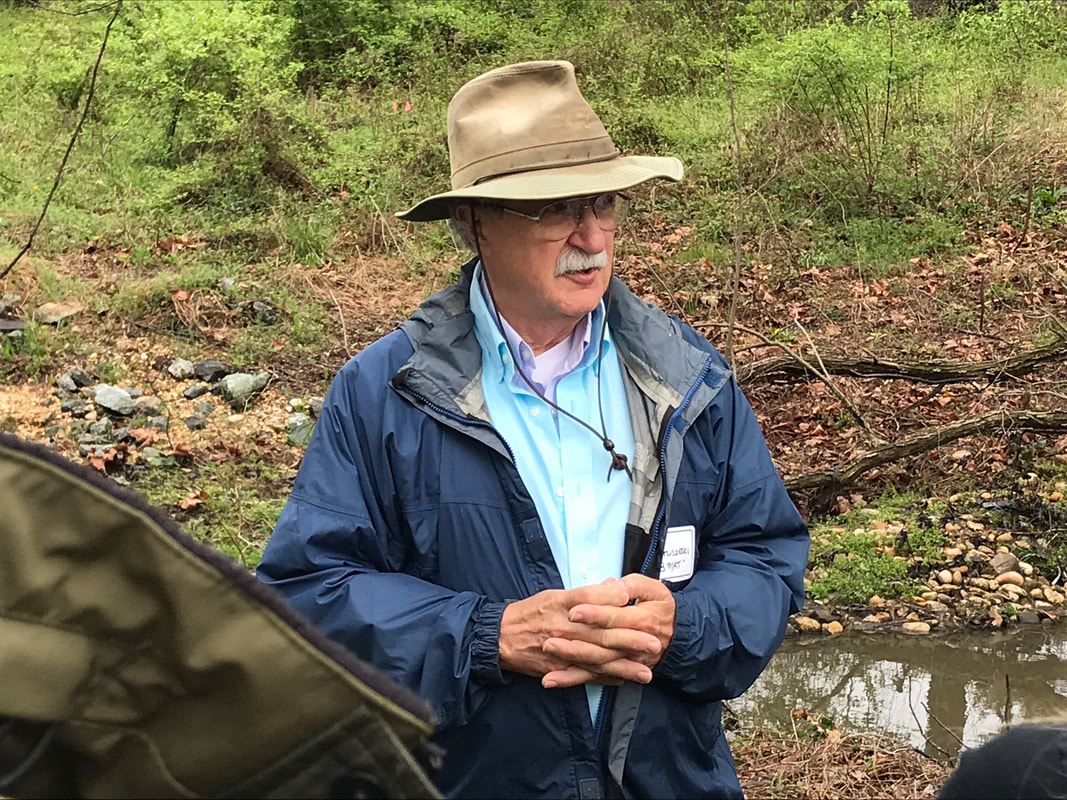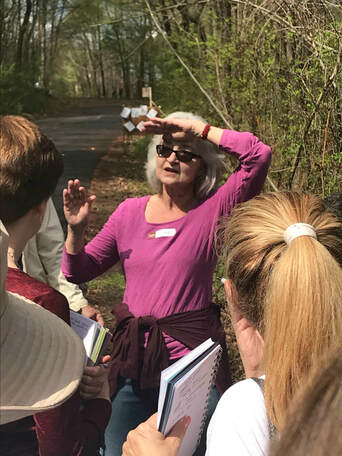|
Dawn Szelc, LDG Secretary Clear Blue Landscapes The March meeting of the LDG was on ponds as water features in the landscape. We had 5 speakers from different companies in the area with expertise in pond design, construction, and management. John Magee, of Magee Design (www.johnmagee.com), has expertise in vernal ponds. Besides landscape design, John has a pod cast called The Native Plant Podcast. In Broadlands, VA he did a boardwalk in a storm water area. It is planted with native plants. He discussed the most common invasive that he sees in these areas, which is miscanthus grass, so emphasized not to use this plant. As a side he also mentioned that there is an 8-foot layer of cigarette butts at the bottom of the Chesapeake Bay! John worked with Alonzo Avogadas, Capital Naturalist and Natural Resource Manager for Arlington Parks, at the Barcroft Park near Four Mile Run. This park has a magnolia bog with many Sweet Bay Magnolia growing naturally there. These trees are semi-evergreen and like moisture. Alonzo creates a temporary pool to support the amphibians’ life cycle. He uses a product called a Quick dam that absorbs water and create a damming effect to collect the rain water in the spring. These vernal pools support the life cycle of wood frogs, spring peepers, and later toads. They tend to be acidic. He discussed that if you have a pond or pool in a landscape, he does not recommend stocking it with koi as they will eat any and all frog or amphibian eggs laid there. He has also noticed that his own pond had many dragon flies when there were not koi resident in it. He also recommends having minnow for controlling algae. John loves pitcher plants which also grow in very wet areas. They are native to northern Michigan and New Hampshire. He showed photos of the Powhatan School in Boyce, VA where they had developed rain gardens. Some of the plants used there include Pawpaw, Hibiscus, Elderberry, Closed gentian, Joe Pye Weed, Cardinal flower, Itea virginica, Fothergilla, Fringe tree, and Cut plant. The next speaker was Don Jump from Harmony Ponds. Don discussed that they do design, construction, maintenance, and repair of any and all types of water features including ponds, fountains, lakes, and waterfalls. Kristen Weaver and Tara Sutton from DC Ponds, LLC are two sisters who have developed a business cleaning and maintaining ponds. They showed many before and after photos of the types of ponds that they have experience draining cleaning and then restoring to function and beauty. It is a very labor intensive job that they love. Lastly, Stephen Koza spoke. He is President of Tropic bay Water Gardens in Davidsonville, MD. His is the largest aquatic garden center on the east coast, and he is a koi specialist. He has green houses that are just for fish sales and has many unusual and special varieties of fish that he hand-selects during visits abroad. His store includes a large selection of backyard art and pottery. Stephen recommends UV sterilizers for better water quality and says the key to a well-maintained pond is filtration. He discussed the trick to keep herons out of your pond and eating the fish is to make the walls at least 3 feet high with straight edges. They are not able to get in to eat the fish. Our final presentation was to bring all the speakers back for a question and answer panel session. LDG President Julie Hawley asked how to begin creating a pond – what materials are used, etc?
All in all the entire evening was very informative and we thank all the speakers for their contributions.
0 Comments
by Clara Aleman, RLA On Saturday, April 13, 2019, the LDG members were invited to attend a lecture and guided tour of the Springhouse stream system restoration program at the National Arboretum from 9:30 and to 11:30 am. Our guide was Bill Matuszeski, Chair of Environmental Committee of the Friends of the National Arboretum, member of the Mayor's Leadership Council for a cleaner Anacostia River, and former Director of the Chesapeake Bay Program. Springhouse Run used to be a concrete conduit of stormwater runoff from New York Ave NE and the commercial areas to the north, running through the arboretum and emptying into the Anacostia River. After a major restoration, it is now a meandering stream, edged by thousands of native plants and populated by fish, frogs, and birds. As a group, and with Bill’s guidance, we visited 4 sites. Project Funding Details
1st site - Hickey Run Past conditions: Hickey Run is considered the most polluted of all the tributaries connected to the Anacostia River. The stream bed used to be piped and concrete swale that would remove water quickly. Site physical features: Bridge over a meandering stream bed. Current restoration efforts: The project started with trash removal and later to the replacement of appropriate soils and plants. Within 3 weeks of completing the meandering stream, fish naturally introduced themselves within the stream. Unfortunately, raw sewage was also identified on the site. Approximately, 61 adjacent sites were identified as wrongfully discharging into the stream. As a result, the restoration efforts at Hickey Run have been temporarily discontinued and another downstream location was identified for restoration. 2nd site – Spring House Past conditions: Previously, there was a ditch that ran through this site and carried water quickly away from the site. Site physical features: D.C.'s original Spring House and the Bottling Building which were built in 1890 and supplied bottled water to the city. A series of swales were added perpendicular to New York Avenue to slow down the runoff. Current restoration efforts: Keith Underwood, the contractor, was responsible for providing 100 pounds of wood chip to the site. Because of his passion for the project, he brought 1000 pounds. This material was used as subgrade fill, providing filtration and cleansing the water. Future efforts: Include applying learned lessons from Spring House and applying them at Hickey Run. 3rd site – Dawn Redwood Tree & Willow Tree Past conditions: Previously, there was a concrete lined ditch that ran through this site and carried water quickly away from the site. The pond here had become disconnected from the stream and so would end up stagnant and covered with algae. Site physical features: This site is marked with the presence of a mature and majestic Dawn Redwood tree, a pond and an over flow dam. Cultural significance: At the far end of the site is the oldest tree on the arboretum property – Willow Oak. The story is, that during the Civil War, the commanding officer stationed at the site, wrote a beautiful love letter to his wife and daughter. Unfortunately, shortly after, he was sent to battle, where he lost his life. Today, the letter survives and is treasured as a symbol of loss love. Current restoration efforts: On this site, a dam was created with tons of gravel, wood chips and large boulders creating a filtering effect of the water. The pool was reconnected to the stream, so there is a flow of water through the pool and a trickle over the dam. On rainy days, it has a continuous flow. The area below the dam had been overrun with invasives and larger trees. All of this was cleared away and the meadow was restored with an addition of 33,000 native plants. Most of the plants were donated by the vendors from MANTS in January. Volunteers have been taking care of them at the arboretum since January. 4th site Past conditions: There is a remnant of the ditch that belonged to the old water system. The stream has old brick dumped into it from a nearby brick factory that existed. Site physical features: The stream here runs under a bridge in the arboretum where large amounts of trash and debris collect. The site has a marked by a large heart shaped pit. Cultural significance: This site was most probably originally used by farmers for soil extraction. Current restoration efforts: It has been converted into a continuous meandering stream in order to slow down the water and filter pollutants from the water. Many of the native plants have been installed at this site. On the day we were there volunteers were cleaning up trash and debris all along the stream for Earth Day Cleanup. The Anacostia River is about a half mile downstream from here. Concluding Remarks
To date, the new steam systems has reduced storm water runoff by 98%. But adjacent uses, like the DC Sanitary Sewer and runoff from New York Avenue will need continued monitoring. This is a work in progress, as testing stations will yield interesting data. As more lands open up for future connections, and stream system expands, it will be exciting to see evolution of the stream system. We are grateful to Bill for sharing his time and knowledge with us and offering us the opportunity to see the project through his eyes. |
AuthorsLDG is a non-profit corporation dedicated to the exchange and enhancement of knowledge relevant to the landscape design profession. We are a group of professional designers in the metropolitan Washington, DC area. Membership is meant for students studying and professionals employed in landscape design or associated professions (i.e. arborists, installers, contractors, etc.). Archives
October 2023
CategoriesPast Newsletters can be found in the Members Only Section of the LDG Membership Connection. You must sign in to view these files.
Past Newsletters |
|
Search for a Landscape Designer in Your Area:
|












 RSS Feed
RSS Feed
